O
ob- (ob) A prefix, meaning inversely or oppositely.
obcompressed (ob-kuhm-PREST) Flattened dorso-ventrally, instead of laterally
obconical (ob-KON-i-kuhl) Inversely conical; having the attachment at the apex.
obcordatus, -a, -um (ahb-kor-DAY-tus) Inversely cordate; heart-shaped with the attachment at the apex, obcordate.
Oberonia (oh-ber-OH-nee-ah) A genus of 300 species of equitant-leaved epiphytic orchids distributed from East Africa to Samoa, it is related to Liparis and was described in 1830 by Lindley, who dedicated it to Oberon, king of the fairies.
ochroleucous (oh-kro-LEW-kus) Yellowish white
oblanceolate: The leaves of Masdevallia datura are oblanceolate.
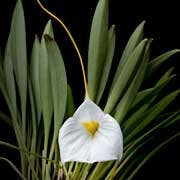
oblanceolate (ob-LAN-see-oh-layt) Inversely lanceolate, with the broadest part toward the apex.
oblique (ob-leek) Having unequal sides; asymmetrical; slanting.
oblong (ob-long) Being longer than broad, and with the sides nearly parallel.
oblongifolius, -a, -um (ob-long-gi-FOH-lee-us) With oblong leaves.
obovate (ob-OH-vayt) Inversely ovate; ovate with the narrow end at the base.
obovoid (ob-OH-voyd) Inversely ovoid; egg shaped with the narrow end at the base.
obryzatus, -a, -um (oh-bry-ZAY-tus) Pure gold color.
obsolescent (ob-suh-LES-uhnt) Becoming rudimentary; gradually disappearing or imperfectly developed.
obsolete (ob-suh-leet) Imperfectly developed or rudimentary.
obtusus, -a, -um (ob-TOO-sus) Blunt or rounded at the tip; having an angle greater than 90 degrees.
obtusifolius, -a, -um (ob-too-si-FOH-lee-us) Blunt-leaved.
ocellatus, -a, -um (oh-sell-LAY-tus) With an eye; having a circular spot of one color inside a larger spot or area of another color.
ochraceus, -a, -um (oh-KRAY-see-us) Yellowish, ocher-colored; ochraceous.
ocreate (oh-KREE-ayt) Having stipules that sheath.
Octomeria (ok-toh-MER-ee-ah) A genus of 135 species of epiphytic orchids from the American tropics, related to Pleurothallis, it was described in 1813 by Robert Brown, the name alluding to the eight pollinia.
oculata: Stanhopea oculata has two dark spots that look like eyes.
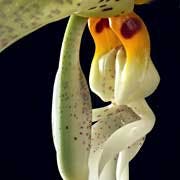
oculatus, -a, -um (ok-yew-LAY-tus) Having one or more dark spots like eyes; oculate.
Odontioda (oh-don-tee-OH-dah) A hybrid genus between Cochlioda and Odontoglossum created in 1906.
odontochilus, -a, -um (oh-don-toh-KYE-lus) Having a toothed lip. Also a genus of terrestrial orchids from Asia and the Pacific.
Odontocidium (oh-don-toh-SID-ee-um) A hybrid genus between Odontoglossum and Oncidium created in 1911.
Odontoglossum (oh-don-toh-GLOSS-um) A genus of 140 species of showy epiphytic orchids from tropical America belonging to the Oncidium alliance. It was established by Humboldt, Bonpland and Kunth in 1815, the name referring to the toothed crest on the lip of most of the species. Now officially included in the genus Oncidium.
Odontonia (oh-don-TOE-nee-ah) A hybrid genus between Odontoglossum and Miltonia (including Miltoniopsis) created in 1905.
odoratus, -a, -um (oh-do-RAY-tus) Fragrant.
odoratissimus, -a, -um (oh-door-a-TISS-i-mus) Very fragrant.
Oeceoclades: Oeceoclades maculata has become a weed in Florida.
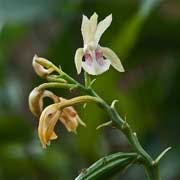
Oeceoclades (ee-see-oh-CLAY-dees) A Pantropical terrestrial genus of 31 species closely allied to and sometimes included in a broadly defined Eulophia, formerly known as Eulophidium. Lindley described the genus in 1832, deriving the generic name from two Greek works for "private" and "branch," to indicate forming a private branch from Angraecum.
Oeonia (oh-ee-oh-NEE-a) There are five epiphytic species in this genus from Madagascar and the Mascarene Islands. Lindley founded the genus in 1824, deriving the generic name from the Greek word for "bird of prey," an allusion to the flowers that slightly resemble birds.
Oersted: Lockhartia oerstedii honors Anders S. Oersted.
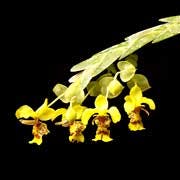
Oersted, Anders S. (1816-1872) Nineteenth-century Danish plant collector and ecologist, particularly important to early Costa Rican phytography.
Oerstedella (ewer-sted-ELL-ah) A former Neotropical genus of 32 species of reedy plants now included in Epidendrum, characterized by verruculose leaf sheaths. H.G. Reichenbach described the genus in 1852, naming it in honor of Andre Santoe Oersted, who collected the original material.
officinalis, -e (oh-fiss-in-AY-lis) Kept in stock by apothecaries. Typically refers to species of ethnobotanical interest.
offset (off-set) A short lateral shoot that may produce another plant; an offshoot.
oleaginous (oh-lee-AJ-in-us) Having the nature or quality of oil.
oliganthis, -a, -um (ol-ig-ANTH-us) With few flowers.
olivaceus, -a, -um (ol-iv-AY-see-us) Greenish brown; olive-colored; olivaceous.
oncidioides (on-sid-ee-OY-deez) Resembling an Oncidium.
Oncidium (on-SID-ee-um) A large genus of epiphytic orchids from tropical America, it was founded by Swartz in 1800, the name alluding to the warty callus on the lip of the species in the genus. The count of species in the genus varies from less than 300 to over 1000 depending on how broadly the genus is circumscribed.
ontogeny The process of development of an organ toward maturity.
opaque Dull; neither shining nor translucent.
operculate (oh-PERK-yew-layt) Lidlike, as some anthers, or furnished with a lid.
operculum (oh-PERK-yew-lum) A cap or lid of an organ, usually shed by circumscissile dehiscence; in orchids, the anther cap.
Ophrys (OFF-riss) A genus of 25 species of terrestrial orchids from the North Temperate Zone of Europe, Africa and Asia, especially around the Mediterranean Sea, established by Linnaeus in 1753, the name derived from the Greek, meaning "eyebrow."
Opsistylis (op-si-STY-lis) A hybrid genus between Rhynchostylis and Vandopsis created in 1970.
opposite (OP-uh-zit) Said of a plant having two leaves at the same node
orbicularis, -e (or-bik-yew-LAY-ris) Having a rounded outline; disc-shaped; orbicular.
orbiculatus, -a, -um (or-bik-yew-LAY-tus) Disc-shaped; orbiculate.
Orchidaceae (or-ki-DAY-see-ee) The largest family of flowering plants including terrestrial and epiphytic herbs from both temperate and tropical regions. A cosmopolitan group related to lilies, palms, grasses and other monocotyledonous plants, the flowers are usually characterized by their bilateral symmetry and the possession of a column representing the fusion of both the male and female reproductive organs.
orchidist (ore-KID-ist) One whose interest in orchids is primarily horticultural.
orchidologist (ore-KID-oll-uh-jist) One who specializes in the study of orchids, particularly their evolution and relationships.
orchidology (ore-KID-oll-uh-gee) The branch of technical botany that deals with orchids and their study.
Orchis (ORE-kiss) There are 30 terrestrial species in this genus widely distributed in Europe and Asia, all the way to China. Carl von Linné founded the genus in 1753, selecting the Greek word meaning "testicle" to describe the two tubers found on these plants.
organelle (ore-GAN-ell) An organized structure within the cell that has a specialized function.
orifice (ore-uh-FISS) An opening.
originator (uh-RIJ-uh-NAY-ter) In reference to the registration of an orchid hybrid, the owner (or his assignee) of the seed-bearing parent at the time of pollination.
Ornithocephalus (or-nith-oh-SEFF-al-us) A genus of 28 species of pseudobulbless fan-shaped epiphytes from the American tropics. Related to Phymatidium and Zygostates, it was established by Hooker in 1825, the name alluding to the resemblance of the column and anther to the head of a bird.
Ornithochilus (or-nith-oh-KYE-luss) The three monopodial epiphytes in this genus come from Southeast Asia, ranging from the Himalayas east to the Malay Peninsula. Lindley founded the genus in 1833, deriving the generic name from two Greek words for "bird" and "lip" to denote the birdlike lips on these flowers.
Ornithophora (or-nith-oh-FORE-a) A monotypic genus native to Brazil. Barbosa-Rodrigues described the genus in 1881, coining the generic name from two Greek words meaning "bird" and "bearing," referring to the column, which appears birdlike in side view.
ornithorhynchus, -a, -um (or-nith-oh-RINK-us) Resembling the beak of a bird.
ortho- (or-tho) A word element meaning "straight" or "upright."
Osmoglossum (oz-moh-GLOSS-um) The three epiphytic species in this genus come from Central America. Schlechter established the genus in 1916, deriving the generic name from two Greek words meaning "scent or odor" and "lip" to denote the fragrance of the flowers.
osmosis (oz-MOH-sis) Diffusion of a solvent such as water through a semipermeable membrane from a dilute to a concentrated solution.
osmundine: Osmunda was once very popular for potting orchids.
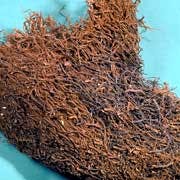
osmundine (oz-MUN-deen) The cut fibrous roots of ferns of the genus Osmunda used as a growing medium for epiphytic orchids; osmunda.
Otochilus (oh-toh-KYE-lus) The four creeping epiphytic species in this genus range from the Himalayas east to Thailand. The genus was founded by Lindley in 1830. He derived the generic name from two Greek words meaning "ear" and "lip," however, the reason behind the naming is not clear.
Otoglossum (oh-toh-GLOSS-um) This genus of seven epiphytic species comes from Central and South America, ranging from Costa Rica south to Peru. Schlechter described these species as a section of Odontoglossum in 1924 and in 1976 Garay and Dunsterville raised the section to the generic level.
ovalis, -e (oh-VAY-liss) Broadly elliptic in shape; oval.
ovary (OH-vah-ree) The part of an orchid flower that becomes the fruit following pollination and fertilization. It contains the ovules, which, if fertilized, become the seeds; in orchids, the ovary is combined with the pedicel to form the pedicellate ovary beneath the flower.
ovatus, -a, -um (oh-VAY-tus) Shaped like the outline of an egg, with the broader end downward; ovate.
overpot (OH-ver-pot) To pot an orchid in a container larger than necessary, allowing more freedom for root growth or for greater plant growth, or allowing for a greater time interval before repotting; in inexperienced hands, this can be detrimental to the plant.
overwater (OH-ver-wah-ter) To keep the medium too wet or too damp, usually degrading the roots and eventually preventing the plant from absorbing needed water and nutrients.
ovoid (OH-voyd) Egg shaped, the larger end toward the stem or axis; used in a three-dimensional sense as opposed to ovate.
ovulate (OV-yuh-layt) Bearing ovules
ovule (OV-yewl) One of the young bodies in the ovary that, upon fertilization, develop into a seed; the female gametophyte.
ovuliferus, -a, -um (oh-vyew-LIF-er-us) Ovule-bearing.









